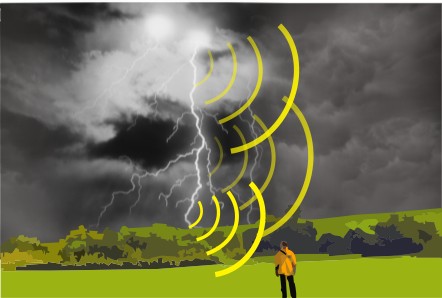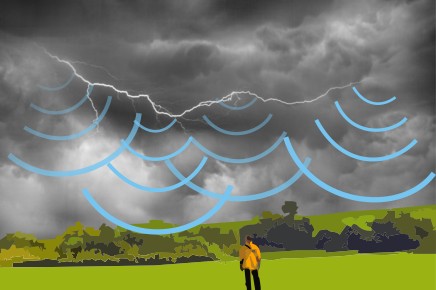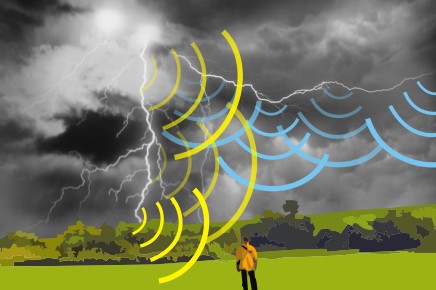How thunder sounds
Where there is lightning there will be thunder, and where there is thunder there will be lightning. The reason: thunder is the sound of the shockwave that lightning produces as it heats up the air to 30,000°C in less than one second. This is five times the temperature on the surface of the sun! The air surrounding the lightning channel or pathway expands explosively and creates a shockwave which produces the sound waves of thunder.
Have you ever wondered why the rumble of thunder can sound differently from one lightning strike to another? Depending on atmospheric conditions, you can hear thunder from as far away as 20 km, or as close as 8 km. How thunder sounds depends on a number of factors: the distance between you and the lightning strike, the temperature of the air, the amount of cloud and water in the air, as well as where the lightning channel is in relation to where you are situated.
Light travels at 300,000 km/second, whereas sound travels at 0.3 km/sec. This is why you can see the flash of lightning sooner than you hear the rumble of thunder that the initial lightning strike produces. As the distance to the lightning strike increases, the pitch of the thunder lowers. This is because the higher frequencies are selectively absorbed. This is just like when there is music playing in another room, you can hear the bass notes but not the high notes.
Sound waves are affected by the air temperature: they move faster in hot air and slower in cold air. They also bend or refract toward areas of lower temperatures similar to how light bends when it moves from air through water. Since the atmosphere usually cools with height, sound waves or thunder tend to deflect upwards. Typically this means if you are on the ground, more than 20 km away from a lightning strike, you will not be able to hear it. See figure A.
However there are differences between day and night. During a summer day, the air near the earth’s surface can be much hotter than the air above, so the sound waves bend toward the cooler air. See figure (A) for a graphic of this process. Conversely, at night, the air near the surface is likely cooler, so the sound waves bend towards the earth’s surface. See figure (B) for a graphic of this process.


There are also differences over water because of the higher humidity near the surface of the water. The bending of the sound waves is enhanced because of the higher humidity so more of the sound waves are blocked. This means the storms have to be closer to you for you to hear the thunder. Lightning could be as close as 8 km away before you actually hear it which would place you within striking distance of being hit by lightning.

A clap is the sound of thunder when the lightning channel is perpendicular to the observer’s line of sight.

A rumble is the sound of thunder when the lightning channel is roughly parallel to the observer’s line of sight. An example of this is when lightning follows a path from one side of the cloud to another.

A combination of claps and rumbles
The sound of thunder will also sound different depending on whether the channel of lightning is associated with cloud to cloud lightning overhead (parallel) or cloud to ground lightning to the side of you (perpendicular).
A sound commonly associated with thunder is the clap. This type of sound occurs when the lightning channel is perpendicular to the observer’s line of sight.
Another sound associated with thunder is the rumble. This is the sound of thunder when the lightning channel is roughly parallel to the observer’s line of sight. An example of this is when lightning follows a path from one side of the cloud to another.
But what happens if there are a number of strikes at once? In this case, sound waves from each part of the strike will reach you at different times and so you may hear a combination of claps and rumbles.
As noted above, light travels at 300,000 km/second, whereas sound travels at 0.3 km/second. Keeping this in mind, once you have transported yourself to a safe location, either in a house or car, you can calculate the distance of the lightning strike. After the flash of lightning, begin counting off the seconds until the thunder is heard. Divide the seconds by three to arrive at the distance in kilometres.
Example: 15 seconds/3 = 5 km away.
*Always remember to stay in a safe location for 30 minutes after the last rumble of thunder is heard.
Listening to thunder: It’s in the sound!
Listening to what thunder sounds like from various distances can be a fun experiment! Just remember that no matter how far away you see lightning, if you hear thunder, you are within striking distance of being hit. Find shelter immediately, either in a house or a car, and stay there for 30 minutes after the last rumble of thunder is heard before resuming your activities. But remember that every thunderstorm has a very first lightning strike that will come without any warning and could occur in your immediate vicinity. So even before thunder roars, you need to keep an eye on the sky.
The following links are a safe and fun way to hear different thunder sounds:
Click on the links below to hear:
- Cloud to ground 8 km
- Cloud to ground 3 km
- Cloud to ground 2 km
- Cloud to ground 1.6 km
- Cloud to ground 300 m
Always remember: “When thunder roars, go indoors!”